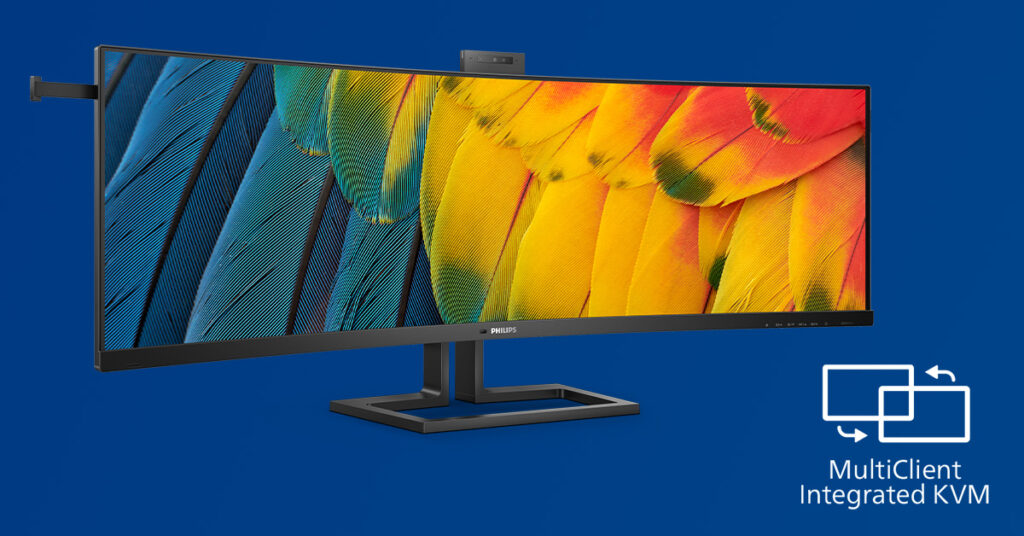Are KVM monitors worth it?

A KVM switch, short for Keyboard, Video, and Mouse switch, is traditionally a hardware device that is now built into monitors and allows users to switch between various PCs easily. This, in turn, can facilitate productivity and it offers a great solution for professionals in need of a multi-source solution. However, you may be asking… what is a KVM switch? Are KVM monitors worth it? In this article, we will answer just that.
Are KVM monitors worth it?
Monitors with an integrated KVM switch are an easy, cost-effective solution for switching between computer systems, but are they worth it?
The answer to this is that they are totally worth it. By using a KVM switch, it means that there’s no need to create two completely separate and expensive set-ups in search for a comfortable experience – you can switch the source just by clicking a button. This makes monitors with KVM switches an exceptional option for gamers and professionals alike.
What are the benefits of KVM monitor?
The main benefit of employing a KVM switch is having easy control of two (or, based on the specific switch, more) PCs and servers from their monitor, keyboard, and mouse setup. This consequently means cutting down the number or peripherals needed in these complex set-ups, which in turn reduces clutter and saves money. In addition, you can even use a KVM switch for dual monitor setups, although it depends on the specific model of the switch and the type of monitor you are using. Businesses and professionals might particularly benefit from this feature since it boosts productivity and facilitates the most complex multitasking. For more information about dual monitor setups, please visit our dedicated article here.
Is KVM good for gaming?
Yes, KVM is extremely useful for gamers who have a gaming PC and a laptop, streamers with two PCs, content creators, game developers or even when prepping devices for a LAN event: To sum it up, KVM switches allows you to maximize your desktop by expanding your access to multiple devices.
A great example of a KVM monitor that is equally adapted to gaming is the Philips Evnia 49M2C8900. Not only does it have the capabilities of gaming at 240Hz with QD OLED-quality imagery, but it also is built with an internal KVM switch that allows gamers to easily use the monitor for work and play. So, by day, professionals can log in on their work PC and then switch over to their gaming PC by night.
Therefore, you might be asking: Is KVM good for gaming? The answer is it is not good, its great! If you would like more information about the Philips Evnia 49M2C8900 monitor, please check out its dedicated product page here.
How do I use KVM on my monitor?
Using a KVM switch is very easy. You just need to plug all your systems, LAN cable, and peripherals directly into the monitor and keep them connected at all times. Then you can easily choose the primary source from the KVM menu. In order to successfully set up the KVM switch function for your monitor, it is always best practice to check your monitor’s user manual and follow the instructions from there.
Do I need a dock or KVM?
KVM and docks are made for different purposes. Docks increase the number of ports available to access multiple external devices for daisy chaining, power delivery, RJ45 connection, and many others. On the other hand, a KVM switch allows users to connect many systems (laptops, PCs) to one set of peripherals (monitor, keyboard, mouse). Therefore, we would suggest that having both a USB-C docking station and a KVM switch is ideal for a state-of-the-art work setup. If you would like more information on USB-C docking stations, please find our dedicated article here.
Monitors with KVM through USB-C
As mentioned above, monitors that offer built-in KVM switches and USB-C connections are the most convenient and future-proof solution for professionals. However, there is no such thing as using KVM through USB-C connection. Usually, a KVM switch is built-in to the monitor itself, where a USB-C connection is built as an external port.
With this being said, it is possible to connect your external devices through USB-C connection and then set up the KVM switch function on the monitor. For information on where to plug your USB-C cable in to be able to successfully set up the built-in KVM function on your monitor, it is best to review the product’s user manual.
In conclusion, it is safe to say that KVM monitors are completely worth it. KVM switches are an essential part of a complex workspace and, at the end of the day, make heavy workflow easier to manage.
